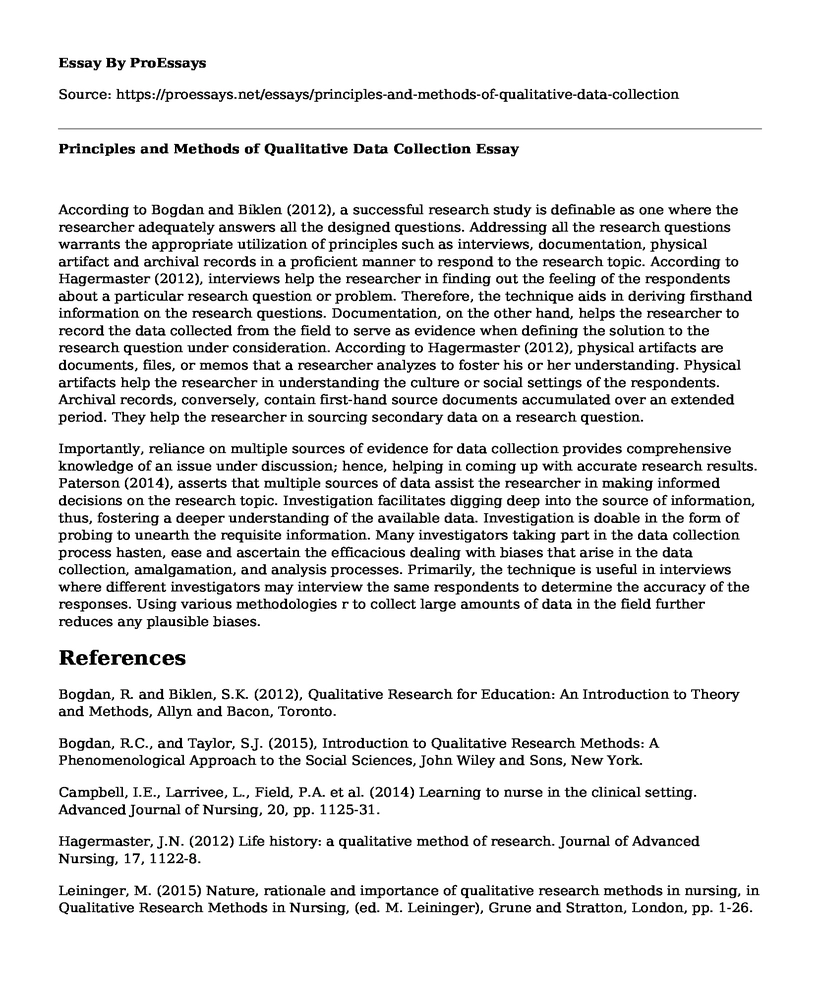According to Bogdan and Biklen (2012), a successful research study is definable as one where the researcher adequately answers all the designed questions. Addressing all the research questions warrants the appropriate utilization of principles such as interviews, documentation, physical artifact and archival records in a proficient manner to respond to the research topic. According to Hagermaster (2012), interviews help the researcher in finding out the feeling of the respondents about a particular research question or problem. Therefore, the technique aids in deriving firsthand information on the research questions. Documentation, on the other hand, helps the researcher to record the data collected from the field to serve as evidence when defining the solution to the research question under consideration. According to Hagermaster (2012), physical artifacts are documents, files, or memos that a researcher analyzes to foster his or her understanding. Physical artifacts help the researcher in understanding the culture or social settings of the respondents. Archival records, conversely, contain first-hand source documents accumulated over an extended period. They help the researcher in sourcing secondary data on a research question.
Importantly, reliance on multiple sources of evidence for data collection provides comprehensive knowledge of an issue under discussion; hence, helping in coming up with accurate research results. Paterson (2014), asserts that multiple sources of data assist the researcher in making informed decisions on the research topic. Investigation facilitates digging deep into the source of information, thus, fostering a deeper understanding of the available data. Investigation is doable in the form of probing to unearth the requisite information. Many investigators taking part in the data collection process hasten, ease and ascertain the efficacious dealing with biases that arise in the data collection, amalgamation, and analysis processes. Primarily, the technique is useful in interviews where different investigators may interview the same respondents to determine the accuracy of the responses. Using various methodologies r to collect large amounts of data in the field further reduces any plausible biases.
References
Bogdan, R. and Biklen, S.K. (2012), Qualitative Research for Education: An Introduction to Theory and Methods, Allyn and Bacon, Toronto.
Bogdan, R.C., and Taylor, S.J. (2015), Introduction to Qualitative Research Methods: A Phenomenological Approach to the Social Sciences, John Wiley and Sons, New York.
Campbell, I.E., Larrivee, L., Field, P.A. et al. (2014) Learning to nurse in the clinical setting. Advanced Journal of Nursing, 20, pp. 1125-31.
Hagermaster, J.N. (2012) Life history: a qualitative method of research. Journal of Advanced Nursing, 17, 1122-8.
Leininger, M. (2015) Nature, rationale and importance of qualitative research methods in nursing, in Qualitative Research Methods in Nursing, (ed. M. Leininger), Grune and Stratton, London, pp. 1-26.
Melbin, M. (2016) Mapping uses and methods, in Human Organization Research: Field Relations and Techniques (eds R.N. Adams and J.J. Preiss), Dorsey Press, Homewood, IL, pp. 255-66.
Miles, N.B. and Huberman, A.B. (2014), Qualitative Data Analysis, 2nd edn, Sage, Thousand Oaks, CA.
Paterson, B.L. (2014), A framework to identify reactivity in qualitative research. Western Journal of Nursing Research, 16, 301-16.
Pearsall, M. (2015) Participant observation as a role and method in behavioral research. Nursing Research, 14(1), 37-42.
Ross, M.M., Rideout, E.M. and Carson, M.M. (2014) The use of the diary as a data collection technique. Western Journal of Nursing Research, 16, 414-25.
Cite this page
Principles and Methods of Qualitative Data Collection. (2022, Apr 04). Retrieved from https://proessays.net/essays/principles-and-methods-of-qualitative-data-collection
If you are the original author of this essay and no longer wish to have it published on the ProEssays website, please click below to request its removal:
- Research Methods: Null and Alternative Hypothesis
- Type of PICOT and Rationale for Choice of this Type of PICOT
- Applied Research: Finding Solutions to Practical Issues - Essay Sample
- Essay Example on Small Businesses to Multinationals: Achieving Competitive Advantage
- Preventing Flu: Sample, Methods & Data Analysis Strategy - Research Proposal Sample
- Crime Statistics of 5 Major Cities - Report Example
- Bumble Bee Balm Pricing Consideration - Report Example







